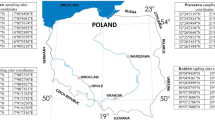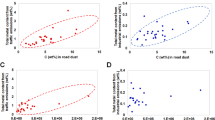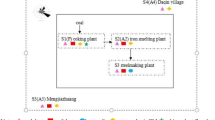Abstract
A large number of diesel vehicles carrying gravel and sand shuttle back and forth every day on the major thoroughfares (Tai-16 and Tai-21) from Shinyi to Jiji in Nantou, Taiwan. A total of 10 stations along the major thoroughfares were selected as the exposure sites, whereas a small village located ∼9 km from a main traffic route was selected as the control site. Outdoor and indoor aerosol samples were collected using high-volume samplers and Harvard samplers, respectively. The metal concentrations of outdoor and indoor PM10 at the exposure sites were, respectively, higher than those at the control site. The plots between metal contents in the aerosols and road dust showed that diesel vehicles contributed significant amounts of metals to the outdoor and indoor aerosols at the exposure sites. Household dust samples along the roadside within 30 m of the main road in the small towns were collected using the wipe method. Based on the results of principal component analysis (PCA), three major components for household dust were identified: resuspended from road dust, brake wear and diesel emissions. Enrichment factors were applied to assess the contribution of pollution sources to household dust. These factors were calculated with respect to unpolluted river dust samples (EFriver) and road dust (EFroad). The differences between EFriver and EFroad could be mainly attributed to the effects of resuspension by passing vehicles. Approximately 72%, 68%, 68%, 73% and 86% of the vehicle-related metals Pb, Zn, Cu, Ni and Mo content, respectively, in household dust were the result of the resuspension of road dust by passing vehicles. The data of daily intakes of five metals (i.e., Fe, Pb, Cu, Ni and Mo) from inhalation and ingestion pathways showed that the doses from the ingestion pathway were much higher than those from the inhalation pathway.
This is a preview of subscription content, access via your institution
Access options
Subscribe to this journal
Receive 6 print issues and online access
$259.00 per year
only $43.17 per issue
Buy this article
- Purchase on Springer Link
- Instant access to full article PDF
Prices may be subject to local taxes which are calculated during checkout






Similar content being viewed by others
References
Cadle S.H., Mulawa P.A., Ball J., Dinase C., Weibel A., Sagebiel J.C., Knapp K.T., and Snow R. Particulate emission rates from in-use high-emitting vehicles recruited in Orange Country, California. Environ Sci Technol 1997: 31: 3405–3412.
Lough G.C., Schauer J.J., Park J.S., Shafer M.M., Deminter J.T., and Weinstein J.P. Emissions of metals associated with motor vehicle roadways. Environ Sci Technol 2005: 39: 826–836.
Muzyka V., Veimer S., and Schmidt N. On the carcinogenic risk evaluation of diesel exhaust: benzene in airborne particles and alterations of heme metabolism in lymphocytes as markers of exposure. Sci Total Environ 1998: 217: 103–111.
Valavanidis A., Fiotakis K., Vlahogianni T., Bakeas E.B., Triantafillaki S., Paraskevopoulou V., and Dassenakis M. Characterization of atmospheric particulates, particle-bound transition metals and polycyclic aromatic hydrocarbons of urban air in the centre of Athens (Greece). Chemosphere 2006: 65: 760–768.
Wang Y.F., Huang K.L., Li C.T., Mi H.H., Luo J.H., and Tsai P.J. Emissions of fuel metal content from a diesel vehicle engine. Atmos Environ 2003: 37: 4637–4643.
Kuo C.Y., Wang J.Y., Chang S.H., and Chen M.C. Study of metal concentrations in the environment near diesel transport routes. Atmos Environ 2009: 43: 3070–3076.
Garg B.D., Cadle S.H., Mulawa P.A., and Groblicki P.J. Brake wear particulate matter emissions. Environ Sci Technol 2000: 34: 4463–4469.
Rogge W.F., Hlldemann L.M., Mazurek M.A., and Cass G.R. Sources of fine organic aerosol. 3. Road dust, tire debris, and organometallic brake lining dust: roads as sources and sinks. Environ Sci Technol 1993: 27: 1892–1904.
Sternbeck J., Sjödin Å., and Andréasson K. Metal emissions from road traffic and the influence of resuspension-results from two tunnel studies. Atmos Environ 2002: 36: 4735–4744.
Weckwerth G. Verification of traffic emitted aerosol components in the ambient air of Cologne (Germany). Atmos Environ 2001: 35: 5525–5536.
Young T.M., Heeraman D.A., Sirin G., and Ashbaugh L.L. Resuspension of soil as a source of airborne lead near industrial facilities and highways. Environ Sci Technol 2002: 36: 2484–2490.
Cadle S.H., Mulawa P.A., Hunsanger E.C., Nelson K., Ragazzi R.A., Barrett R., Gallagher G.L., Lawson D.R., Knapp K.T., and Snow R. Composition of light-duty motor vehicle exhaust particulate matter in the Denver, Colorado Area. Environ Sci Technol 1999: 33: 2328–2339.
Huang X., Olmez I., Aras N.K., and Gordon G.E. Emissions of trace elements from motor vehicles: potential marker elements and source composition profile. Atmos Environ 1994: 28: 1385–1391.
Lowenthal D.H., Zielinska B., Chow J.C., Watson J.G., Gautam M., Ferguson D.H., Neuroth G.R., and Stevens K.D. Characterization of heavy-duty diesel vehicle emissions. Atmos Environ 1994: 28: 731–743.
Pierson W.R., and Brachaczek W.W. Particulate matter associated with vehicles on the road. II. Aerosol Sci Technol 1983: 2: 1–40.
Adgate J.L., Weisel C., Wang Y., Rhoads G.G., and Lioy P.J. Lead in house dust: relationships between exposure metrics. Environ Res 1995: 70: 134–147.
Chiang W.F., Yang H.J., Lung S.C.C., Huang S., Chiu C.Y., Liu I.L., Tsai C.L., and Kuo C.Y. A comparison of elementary schoolchildren’s exposure to arsenic and lead. J Environ Sci Health, Part C 2008: 26: 237–255.
Naspinski C., Lingenfelter R., Cizmas L., Naufal Z., He L.Y., and Islamzadeh A.A. Comparison of concentration of polycyclic aromatic hydrocarbons detected in dust samples from various regions of the world. Environ Int 2008: 34: 988–993.
US Environmental Protection Agency (US EPA). Sampling House Dust for Lead, Office of Pollution Prevention and Toxics. Office of Prevention, Pesticides, and Toxic Substances, Washington, DC EPA/747/R-95/007 1995.
Manalis N., Grivas G., Protonotarios V., Moutsatsou A., Samara C., and Chaloulakou A. Toxic metal content of particulate matter (PM10), within the Greater Area of Athens. Chemosphere 60: 557–566 (2005).
Furusjö E., Sternbeck J., and Cousins A.P. PM10 source characterization at urban and highway roadside locations. Sci Total Environ 2007: 387: 206–219.
Chao C.Y., and Wong K.K. Residential indoor PM10 and PM2.5 in Hong Kong and the elemental composition. Atmos Environ 2002: 36: 265–277.
Geller M.D., Chang M., Sioutas C., Ostro B.D., and Lipsett M.J. Indoor/outdoor relationship and chemical composition of fine and coarse particles in the southern California deserts. Atmos Environ 2002: 36: 1099–1110.
Councell T.B., Duckenfield K.U., Landa E.R., and Callender E. Tire-wear particles as a source of zinc to the environment. Environ Sci Technol 2004: 38: 4206–4214.
Sanders P.G., Xu N., Dalka T.M., and Maricq M.M. Airborne brake-wear debris: size distributions, composition, and a comparison of dynamometer and vehicle tests. Environ Sci Technol 2003: 37: 4060–4069.
Torre C., Mattutino G., Vasino V., and Robino C. Brake linings: a source of non-GSR particles containing lead, barium, and antimony. J Forensic Sci 2002: 47: 494–504.
Kuo C.Y., Wang J.Y., Yeh C.J., Chenc M.C., Kuoa C.W., Chiang C.Y., and Choua H.L. Metal exposure for residents near diesel transport routes. J Environ Sci Health C 2010: 28: 22–38.
Laschober C., Limbeck A., Rendl J., and Puxbaum H. Particulate emissions from on-road vehicles in the Kaisermühlen-tunnel (Vienna, Austria). Atmos Environ 2004: 38: 2187–2195.
Sharma M., Agarwal A.K., and Bharathi K.V.L. Characterization of exhaust particulates from diesel engine. Atmos Environ 2005: 39: 3023–3028.
Gao Y., Nelson E.D., Field M.P., Ding Q., Li H., Sherrell R.M., Gigliotti C.L., Van Ry D.A., Glenn T.R., and Eisenreich S.J. Characterization of atmospheric trace elements on PM2.5 particulate matter over the New York-New Jersey harbor estuary. Atmos Environ 2002: 36: 1077–1086.
Güllü G., Doǧan G., and Tuncel G. Atmospheric trace element and major ion concentrations over the eastern Mediterranean Sea: identification of anthropogenic source regions. Atmos Environ 2005: 39: 6376–6387.
Voutsa D., Samara C., Kouimtzis T.H., and Ochsenkühn K. Elemental composition of airborne particulate matter in the multi-impacted urban area of Thessaloniki, Greece. Atmos Environ 2002: 36: 4453–4462.
Author information
Authors and Affiliations
Corresponding author
Ethics declarations
Competing interests
The authors declare no conflict of interest.
Additional information
Supplementary Information accompanies the paper on the Journal of Exposure Science and Environmental Epidemiology website
Supplementary information
Rights and permissions
About this article
Cite this article
Kuo, CY., Wang, JY., Liu, WT. et al. Evaluation of the vehicle contributions of metals to indoor environments. J Expo Sci Environ Epidemiol 22, 489–495 (2012). https://doi.org/10.1038/jes.2012.55
Received:
Accepted:
Published:
Issue Date:
DOI: https://doi.org/10.1038/jes.2012.55
Keywords
This article is cited by
-
Active moss biomonitoring of airborne potentially toxic elements in recreational areas of Moscow
Environmental Monitoring and Assessment (2024)
-
Development of a Static Model to Identify Best Management Practices for Trace Metals from Non-Exhaust Traffic Emissions
Environmental Processes (2019)
-
PM2.5 pollution from household solid fuel burning practices in Central India: 2. Application of receptor models for source apportionment
Environmental Geochemistry and Health (2018)
-
Trace element contents in fine particulate matter (PM2.5) in urban school microenvironments near a contaminated beach with mine tailings, Chañaral, Chile
Environmental Geochemistry and Health (2018)
-
Soil ingestion rates for children under 3 years old in Taiwan
Journal of Exposure Science & Environmental Epidemiology (2017)



